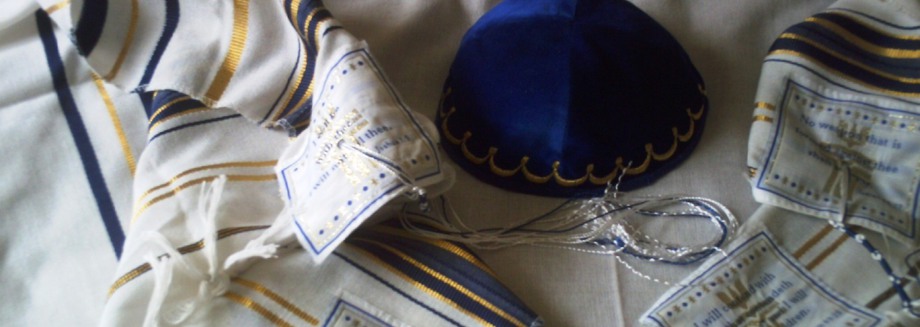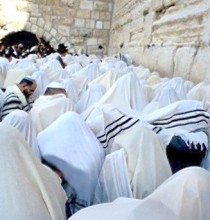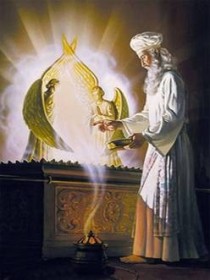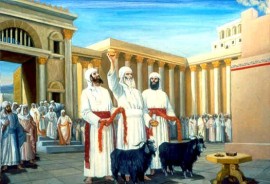
Yom Kippur and the Messianic Believer
Biblically, Yom Hakippurim (Day of Atonements)
"The Lord said to Moses, "The tenth day of this seventh month is the Day of Atonement. Hold a sacred assembly and deny yourselves, and present an offering made to the Lord by fire. Do no work on that day, because it is the Day of Atonement, when atonement is made for you before the Lord your God."
~ Leviticus 23: 26-28 ~
Jewish eschatology teaches that on the Day of Atonement after six thousand years are complete, the Day of the Lord will come. On that day the shofar will sound and the righteous will be resurrected
(Rev. 3:7-11).
Israel's national day of reconciliation with her God, when sins of the nation were atoned for. Humiliation, mourning and humbling of soul is the focus rather than sacrifice. Only the High Priest officiated, in white linen, rather than adorned robes.
What is the prophetic fulfillment of the Day of Atonement?
Zechariah 3:9; 12:10-14 – the removal of Israel's sin and the pouring out of God's Spirit on them... Romans 11:25-26: "...and so all Israel will be saved."
When will it take place?
Prior to Messiah’s return, as a blessing for the Church. As Messiah returns for the Church, Israel will be brought to repentance.
In the Bible, Yom Kippur bears three names:
1) the Day of Atonement,
2) the Day of Judgment,
3) and the Sabbath of Sabbaths.
The Day of Atonement served as a reminder that the daily, weekly, and monthly sacrifices made at the altar of burnt offering were not sufficient to atone for sin. Even at the altar of burnt offering the worshipper stood “afar off,” unable to approach the Holy Presence of God, who was manifest between the cherubim in the Holy of Holies.
On this one day in the year, atoning blood was brought into the Holy of Holies, the divine throne room, by the high priest as the representative of the people (New Bible Dictionary)
The High Priest was central
The high priest is entirely responsible for the Day of Atonement. He began preparing for this day a week early. He stayed in the high priest chamber in the temple court and studied the laws of the Day of Atonement. It was very important the priest not make a mistake. An error could cost him his life and the nation of Israel’s atonement.
The high priest spoke a word this day that was unspeakable all other times. During the services he voiced the Holy name of God, YHWH or more likely Yahovah ten times during the ceremony. When the people heard the Holy Name they fell on the ground in reverence.
Jewish Customs at Yom Kippur
Even many secular Jews will attend synagogue on Yom Kippur!
No-one is barred from synagogue, their mere presence is considered a sign of penitence, and it is never delayed, even for a Sabbath Day.
Fasting and not working are mandatory, and white is worn to symbolise the desire for purity and forgiveness (cf. Isa. 1:18):
"Though your sins are like scarlet, they shall be as white as snow; though they are red as crimson, they shall be like wool."
Messiah, the Scapegoat at Yom Kippur
Yeshua is our atoning sacrifice - his blood brought redemption for us all!
He is our High Priest - went into the Holiest Place in heaven on our behalf (Hebrews 9:11-12) Sin offerings could only go so far – skin deep, they couldn’t cleanse from within. Yom Kippur is annual, but Yeshua’s redemption is forever!
The Scapegoat
After purifying the holy place and the altar of burnt offering with the mingled blood of the bullock, the High Priest went to the eastern side of the court in front of the Temple. Facing him were two identical goats.
Nearby was a lottery box especially designed for this ceremony. In the box were two tablets (lots). One bore the name “For God,” the other “For azazel” (the scapegoat). The high priest shook the box and withdrew the tablets, putting one tablet in front of each goat. The goat labelled “for God” was sacrificed.
The priest laid his hands upon the goat’s head labelled “for azazel” and confessed over it the sins of Israel. The scapegoat symbolically bore the sins of the nation of Israel away from the people. This goat, commonly called the scapegoat (i.e. escape goat), was then driven into the desert.
In the same way Yeshua was brought before Pilate and stood before the people just as He was about to be led forth, bearing the iniquities of the people. These two goats were required for one sacrifice (Lev 16:17, 21-22).
Both sacrifices were fulfilled in the death and resurrection of Messiah Yeshua. How can resurrection be portrayed in a sacrifice? By using two animals, one killed, the other set free, representing Yeshua’s death and resurrection.




